Stanford Reservoir Spillway Extension (2018)
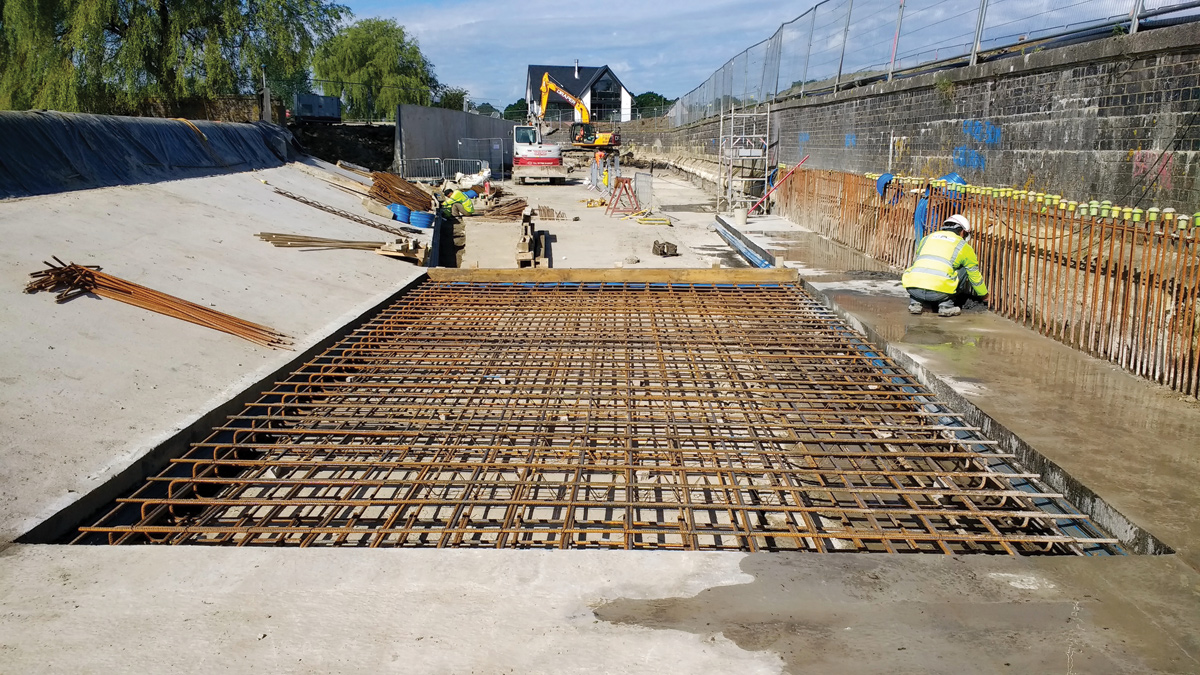
Working adjacent to the reservoir weir - Courtesy of NMCNomenca (now Galliford Try)
Stanford Reservoir is an impounding reservoir that is located in the upper reaches of the River Avon. The catchment area of the reservoir is 55.2km2. This scheme was developed following a Section 10 Report (MWH – now Stantec UK – 2014), where after the re-categorisation of the reservoir from B to A, the Inspecting Engineer considered that the existing overflow structures were not adequate to ensure the safety of the reservoir during the discharge of the design flood. If there were to be a catastrophic dam failure the water flow would encompass two hamlets and a suburb of Rugby with possible loss of life and therefore the spillway capacity needed to be increased to ensure safety.
Section 10 Report
The 2014 report included the following key findings:
- The walls of the primary overflow are distressed and in need of repair or replacement.
- The primary spillway has insufficient capacity to accommodate the design flood.
- The adequacy of the auxiliary overflow is uncertain under long duration overflowing events.
- Safety improvements are needed to reduce the risk of dam failure due to overtopping.
- Safety improvements are needed to increase the outlet works capacity.
The following recommendations were subsequently made:
- The overflow capacity be upgraded.
- Drawdown capacity shall be upgraded.
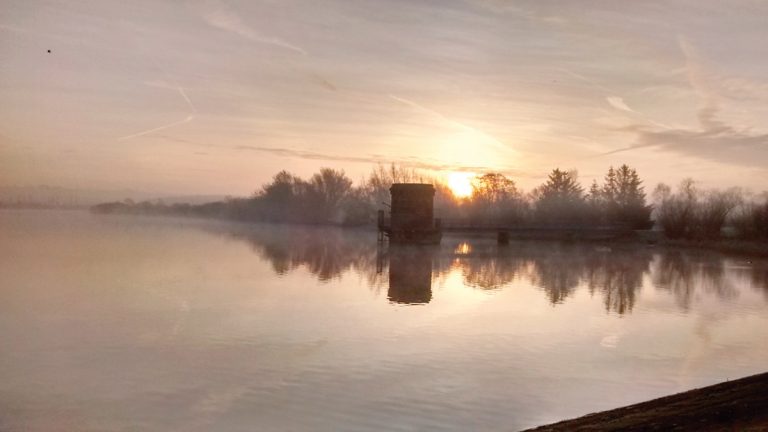
Stanford Reservoir – Courtesy of NMCNomenca
Design
Severn Trent Water commissioned NMCNomenca (now Galliford Try) to upgrade the reservoir spillway and subsequently Atkins was commissioned to undertake the detailed design. The scope consisted of:
- Detailed design of upgrade works to the existing spillway and tunnel.
- Specification for the upgrade works.
- Contractor liaison for the definition of the temporary excavations, diversions works and construction sequencing.
The solution chosen to increase the spillway capacity was to discharge the required design flow of 80m3/s keeping the level of the reservoir below the level of the crest of the auxiliary spillway.
This resulted in the widening of the bye-wash channel by 5.4m to an overall width of 11.5m. With this arrangement, the duration of velocities overtopping the dam above 6m/s for the Safety Critical Flood scenario was reduced from the current 9 hours to only 3 hours, with the peak velocity reduced from the current 7.5m/s to 6.4m/s. This will ensure that the dam will not be damaged by a flood event due to the existing concrete revetment block reinforcement.
The existing channel walls have evidence of movement and therefore the construction of a drain on the back of the existing wall along with the construction of new concrete reinforced wall in front was required.
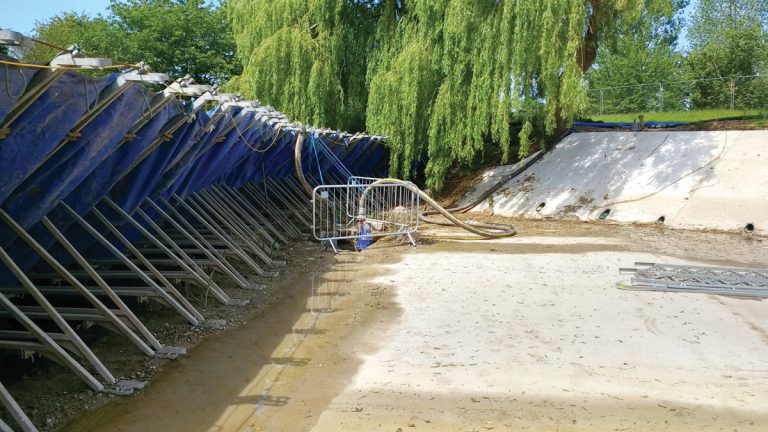
Porta dam for the River Avon – Courtesy of NMCNomenca
Construction
A key element of the design and build (NEC3) contract was to ensure that during the construction of these works the safety of the reservoir would not be compromised. The construction phase started in February 2017 and consisted of the following:
Tail bay work
- Damming and dewatering of work area.
- Excavation and removal of fill.
- Placement and compaction of gravel.
- Reinforced concrete slab pours.
- Expansion/construction joints between pours.
- Installation of weep holes.
Spillway works
- Excavation and removal of fill.
- Demolition of the existing spillway.
- Perforated drainage pipe installation
- No fines concrete binding layer.
- Reinforced concrete wall and slab pours.
- Installation of rodding points.
- Armorlock ground protection installation.
- Dwarf wall pours.
- Eel pass construction between the dwarf wall and spillway wall.
- Removal of existing steel bridge and installation of a new one.
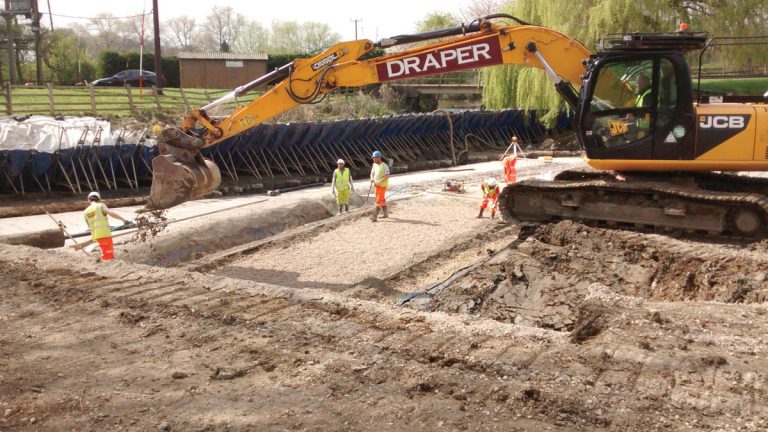
Working behind the dam – Courtesy of NMCNomenca
Tower and tunnel works
- Leak sealing works have been carried out on Priestley Wharf by installing injection packers either side of the joint, then injecting a polyurethane resin (UR63) into the joint by using an injection pump. All holes which were left by the packer have been filled with water stop plugs.
- 400mm x 400mm x 400mm PN16 tee, 1 (No.) 400mm PN16 knife valve and 1 (No.) 400mm PN16 restraint straight coupler installed.
- Installation of hydraulic power pack.
The key to this successful project was the management of the temporary works to enable the work to be carried out without compromising the safety of the reservoir. This included:
- The need to keep the full working capacity of the existing spillway in place whilst carrying our demolition and construction activities.
- Installation of a dam within the River Avon to ensure work can be completed on the tail bay.
- Carrying out work on the dam core safely, and without risk to dam’s integrity.
- Reduction of the reservoir level to enable operatives to work safely in the working spillway and maintaining the level throughout dry and flood conditions.
- Maintaining a clear flood plain in line with EA requirements.
- Ensuring that fish stocks were not affected by reduced reservoir levels, lack of flow though the reservoir, or lack of oxygen.
- Managing the flow from the reservoir bypass, local sewage works and groundwater runoff.
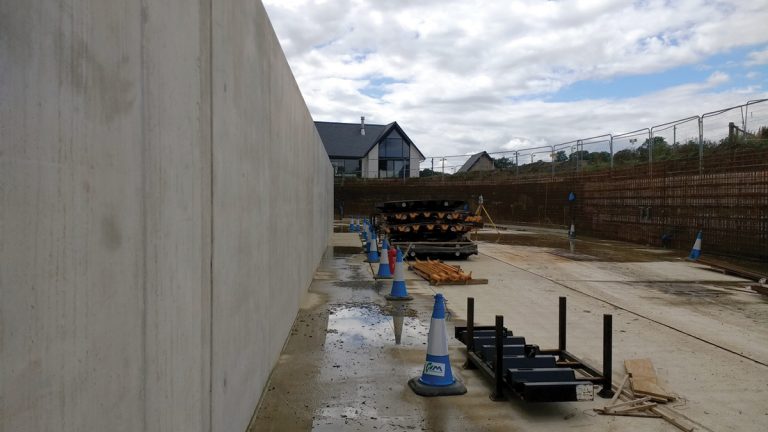
Pedestrian walkways – Courtesy of NMCNomenca
Stakeholder m anagement
There were a number of stakeholders involved with the success of the project. These included:
- The fishing club that operates at the reservoir: Agreed access arrangements, emergency arrangements and timescales and care of the environment and fish stocks.
- Local residents: Especially the adjacent house which was rebuilt during the project.
- The Environment Agency: NMCNomeca worked within the channel of a ‘major river’ and had to have a permit for the work. An eel pass was also included as a betterment to the previous spillway arrangement.
- Teams within Severn Trent Water: Including Wholesale Operations, Asset Creation and reservoir engineers.
- Qualified civil engineer.
As the phases of the construction progressed, and the weather changed the temporary works methodology around the reservoir were regularly reviewed and modified. This was carried out collaboratively between all the parties to ensure that all stakeholders were happy with the work being carried out.
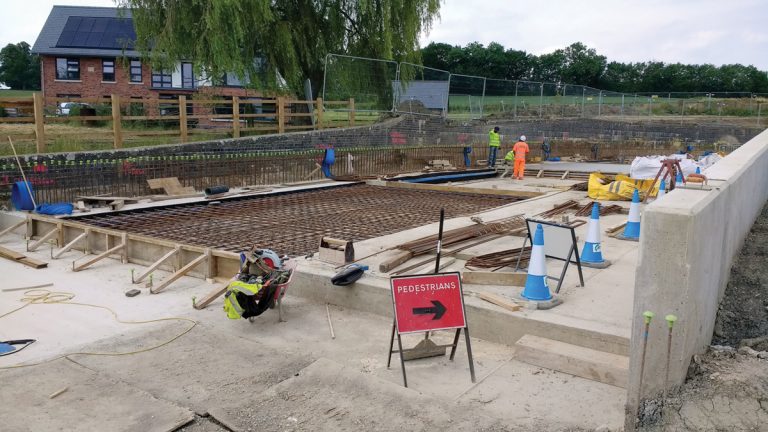
Construction underway – Courtesy of NMCNomenca
Health, safety and environment
From the outset of the feasibility consideration was given to the health, safety and environment during both the construction phase, and also in the maintenance phase. The safety considerations during construction included:
- Safety of the workforce working in a live spillway.
- Flooding risks.
- Safe access to carry out concrete works behind the existing wall in private land.
- Working at height.
- Restriction on the use of large plant at the toe of the dam.
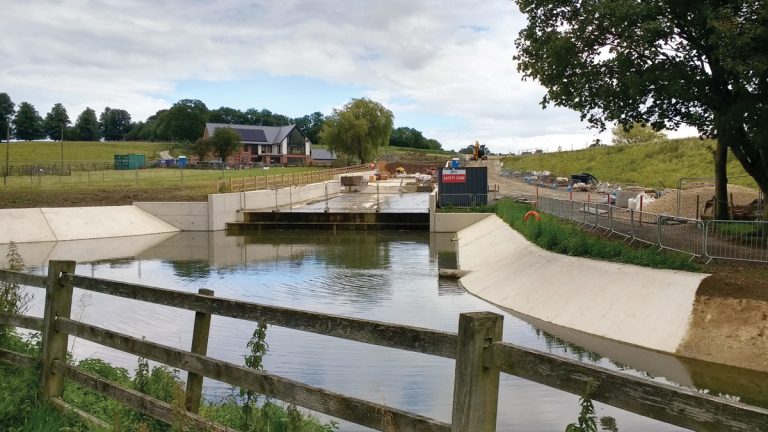
Partially constructed spillway from the tail bay – Courtesy of NMCNomenca
The Environmental considerations during construction included:
- Protection of the otters which were present adjacent to the tail bay.
- Ensuring no construction runoff into the River Avon.
- Working within the channel and ensuring that a flood could pass the works without any restrictions.
- Ensuring no environmental incidents whilst carrying out major over pumping.
- Proactive fish rescues carried out as parts of the existing system were drained or flow would not be sufficient for the water to be aerated.
- Maintaining oxygen levels in the reservoir in hot weather.
The main environmental consideration was the proximity of the water course and brook. Barriers were placed at the bottom of the slopes with filtration to ensure that there was no run off, and that no materials, or fuel spillages could enter the water.
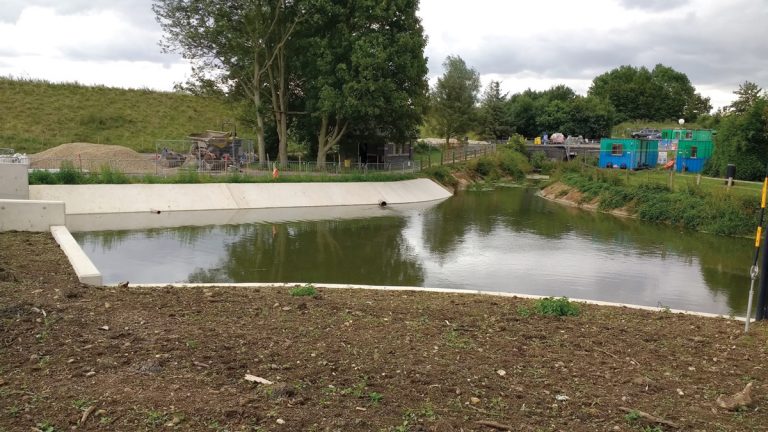
Tail bay of the spillway – Courtesy of NMCNomenca
Conclusion
This successful project was delivered on time and on budget through careful planning and collaborative working. Prior to commencement on site there was a focus on the temporary flow management which ensured that at all times flood water could flow down the partially demolished/constructed spillway whilst ensuring the safety of the dam and of the workforce at all times. Whilst traditional construction methods were used during the construction, it was managed by the design and build team using lean construction tools such as collaborative planning, reducing the construction phase and ensuring focus on high risk activities.




